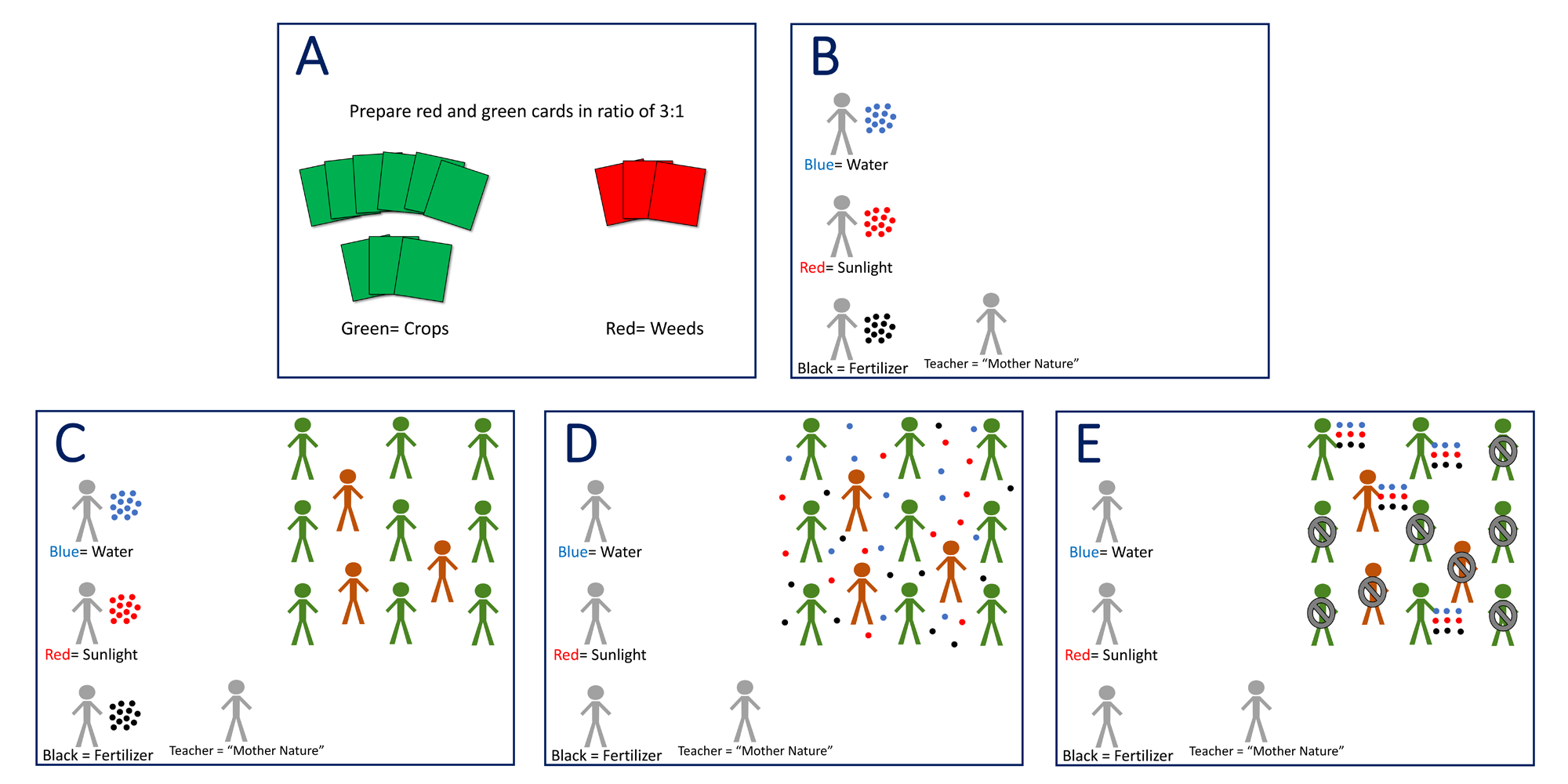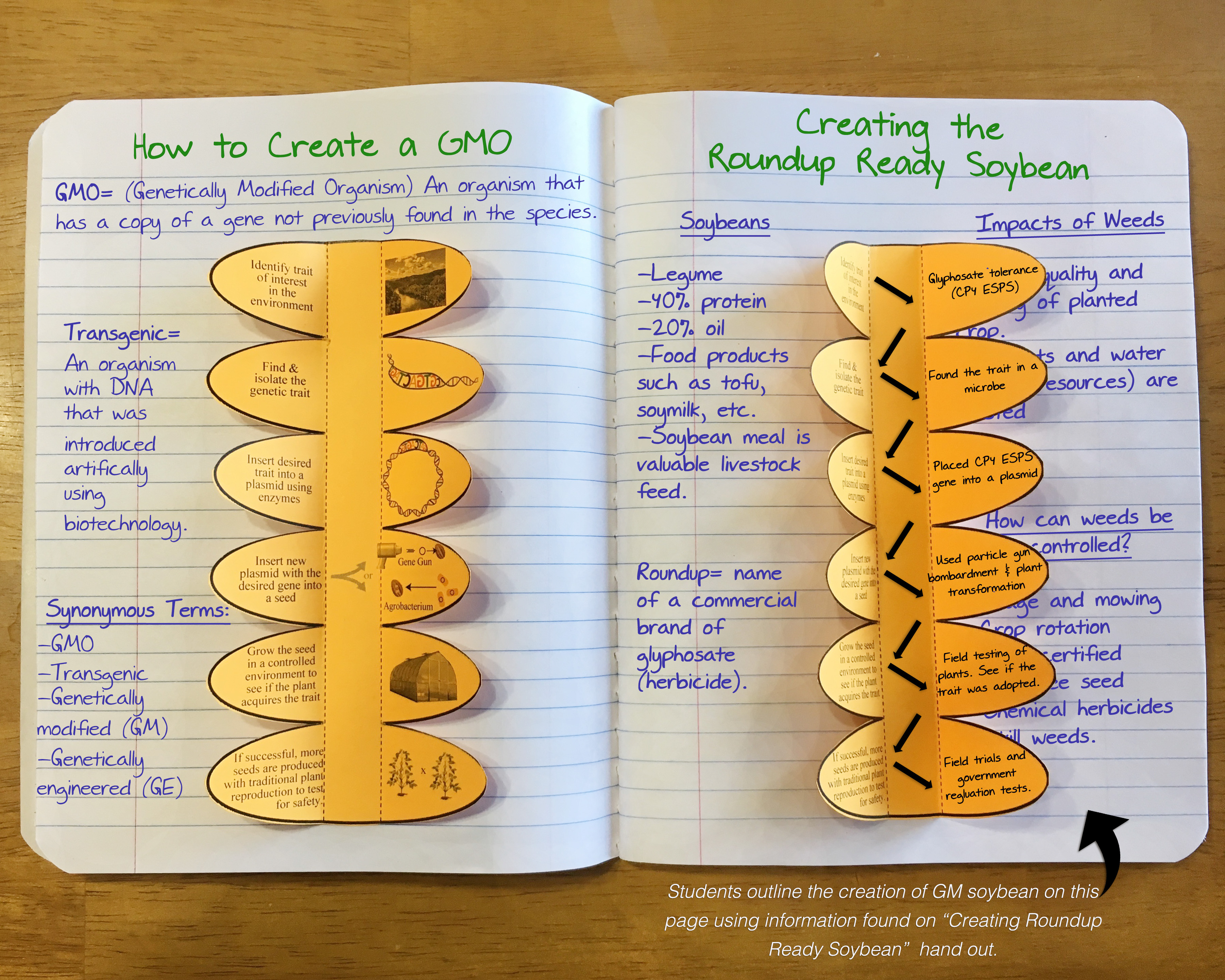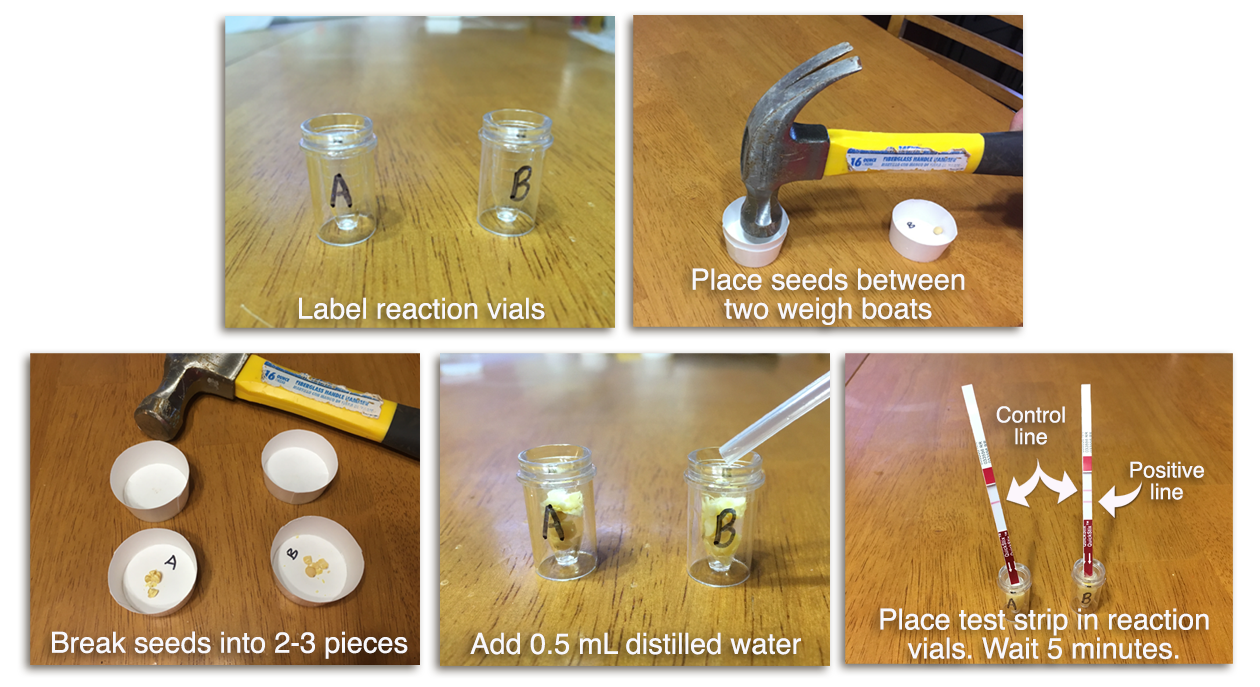The Science of GMOs
Students will map the scientific process of creating a bioengineered (GMO) plant, compare bioengineered soybean seeds to conventional soybean seeds, describe the impact weeds have on plant growth, and understand how a bioengineered seed can help farmers manage weeds.
Background
Lesson Activities
Recommended Companion Resources
Credits
Author
Andrea Gardner and Debra Spielmaker | National Center for Agricultural Literacy (NCAL)
Acknowledgements
With permission, portions of this lesson were adapted by the National Center for Agricultural Literacy from the original lesson packet, Crop Biotechnology: Growing and Testing Roundup Ready Soybean provided by Monsanto in 2018. The lesson was revised again in 2022.
Sources
- https://www.ers.usda.gov/data-products/adoption-of-genetically-engineered-crops-in-the-us.aspx
- https://gmoanswers.com/ask/when-did-humans-first-start-genetically-modify-food-and-why
- http://www8.nationalacademies.org/onpinews/newsitem.aspx?RecordID=23395
- https://en.wikipedia.org/wiki/History_of_plant_breeding
- https://www.biofortified.org/2015/07/crop-modification-techniques-infographic/
- http://www.biologydiscussion.com/plants/protoplasts-plants/protoplast-fusion-meaning-methods-and-its-mechanisms/26481
- http://www.aphis.usda.gov/brs/aphisdocs/93_25801p.pdf
- http://sitn.hms.harvard.edu/flash/2015/how-to-make-a-gmo/
- http://www.agriinfo.in/default.aspx?page=topic&superid=1&topicid=350
- http://www.acsh.org/news/2016/04/22/crispr-edited-foods-coming-to-a-store-near-you-soon
- https://extension.psu.edu/introduction-to-weeds-and-herbicides
- http://www.agbioforum.org/v2n2/v2n2a02-carpenter.htm
- https://www.ers.usda.gov/data-products/adoption-of-genetically-engineered-crops-in-the-us/recent-trends-in-ge-adoption.aspx
- https://www.nap.edu/read/10977/chapter/5#43
- https://www.isaaa.org/resources/publications/briefs/52/download/isaaa-brief-52-2016.pdf
- https://www.biofortified.org/2014/02/conservation-tillage/
- http://www.annualreviews.org/doi/abs/10.1146/annurev-arplant-050213-040039
Standards
Texas Content Area Standards
-
Principles of Agriculture, Food, and Natural Resources: 130.2.c.1
The student demonstrates professional standards/employability skills as required by business and industry. The student is expected to:
- Principles of Agriculture, Food, and Natural Resources: 130.2.c.1.B: apply competencies related to resources, information, interpersonal skills, problem solving, critical thinking, and systems of operation in agriculture, food, and natural resources.
-
Principles of Agriculture, Food, and Natural Resources: 130.2.c.4
The student explains the historical, current, and future significance of the agriculture, food, and natural resources industry. The student is expected to:
- Principles of Agriculture, Food, and Natural Resources: 130.2.c.4.A: define the scope of agriculture.
- Principles of Agriculture, Food, and Natural Resources: 130.2.c.4.B: analyze the scope of agriculture, food, and natural resources and its effect upon society.
- Principles of Agriculture, Food, and Natural Resources: 130.2.c.4.C: evaluate significant historical and current agriculture, food, and natural resources developments.
- Principles of Agriculture, Food, and Natural Resources: 130.2.c.4.E: describe how emerging technologies and globalization impacts agriculture, food, and natural resources.
- Principles of Agriculture, Food, and Natural Resources: 130.2.c.4.F: compare and contrast issues impacting agriculture, food, and natural resources such as biotechnology, employment, safety, environment, and animal welfare issues.
- Principles, of Agriculture, Food, and Natural Resources: 130.2.c.4.D: identify potential future scenarios for agriculture, food, and natural resources systems, including global impacts.
-
Principles of Agriculture, Food, and Natural Resources: 130.2.c.6
The student demonstrates appropriate personal and communication skills. The student is expected to:
- Principles of Agriculture, Food, and Natural Resources: 130.2.c.6.A: demonstrate written and oral communication skills appropriate for formal and informal situations such as prepared and extemporaneous presentations.
- Principles of Agriculture, Food, and Natural Resources: 130.2.c.6.B: demonstrate effective listening skills appropriate for formal and informal situations.
-
Principles of Agriculture, Food, and Natural Resources: 130.2.c.7
The student applies appropriate research methods to agriculture, food, and natural resources topics. The student is expected to:
- Principles of Agricultures, Food, and Natural Resources: 130.2.c.7.A: discuss major research and developments in the fields of agriculture, food, and natural resources.
-
Principles of Agriculture, Food, and Natural Resources: 130.2.c.11
The student develops technical knowledge and skills related to plant systems. The student is expected to:
- Principles of Agriculture, Food, and Natural Resources: 130.2.c.11.C: describe plant reproduction, genetics, and breeding.
- Principles of Agriculture, Food, and Natural Resources: 130.2.c.11.D: identify plants of importance to agriculture, food, and natural resources
- Principles of Agriculture, Food, and Natural Resources: 130.2.c.11.E: use tools, equipment, and personal protective equipment common to plant systems.
-
World Geography Studies: 113.43.d.21
Social studies skills. The student applies critical-thinking skills to organize and use information acquired through established research methodologies from a variety of valid sources, including technology. The student is expected to:
- World Geography Studies: 113.43.d.21.F: formulate and communicate visually, orally, or in writing a claim supported by evidence and reasoning for an intended audience and purpose
-
Economics with Emphasis on the Free Enterprise System and Its Benefits: 113.31.d.21
Social studies skills. The student applies critical-thinking skills to organize and use information acquired through established research methodologies from a variety of valid sources, including technology. The student is expected to:
- Economics with Emphasis on the Free Enterprise System and Its Benefits: 113.31.d.21.F: formulate and communicate visually, orally, or in writing a claim supported by evidence and reasoning for an intended audience and purpose
-
English I: 110.36.c.1
Developing and sustaining foundational language skills: listening, speaking, discussion, and thinking--oral language. The student develops oral language through listening, speaking, and discussion.
- English I: 110.36.c.1.A: engage in meaningful and respectful discourse by listening actively, responding appropriately, and adjusting communication to audiences and purposes;
- English I: 110.36.c.1.D: participate collaboratively, building on the ideas of others, contributing relevant information, developing a plan for consensus building, and setting ground rules for decision making
-
English I: 110.36.c.5
Response skills: listening, speaking, reading, writing, and thinking using multiple texts. The student responds to an increasingly challenging variety of sources that are read, heard, or viewed.
- English I: 110.36.c.5.B: write responses that demonstrate understanding of texts, including comparing texts within and across genres
- English I: 110.36.c.5.E: interact with sources in meaningful ways such as notetaking, annotating, freewriting, or illustrating
-
English II: 110.37.c.1
Developing and sustaining foundation language skills: listening, speaking, discussion, and thinking--oral language. The student develops oral language through listening, speaking, and discussion.
- English II: 110.37.c.1.A: engage in meaningful and respectful discourse when evaluating the clarity and coherence of a speaker's message and critiquing the impact of a speaker's use of diction and syntax
- English II: 110.37.c.1.D: participate collaboratively, building on the ideas of others, contributing relevant information, developing a plan for consensus building, and setting ground rules for decision making
-
English III: 110.38.c.1
Developing and sustaining foundational language skills: listening, speaking, discussion, and thinking--oral language. The student develops oral language through listening, speaking, and discussion.
- English III: 110.38.c.1.A: engage in meaningful and respectful discourse when evaluating the clarity and coherence of a speaker's message and critiquing the impact of a speaker's use of diction and syntax
- English III: 110.38.c.1.D: participate collaboratively, offering ideas or judgments that are purposeful in moving the team toward goals, asking relevant and insightful questions, tolerating a range of positions and ambiguity in decision making, and evaluating the work of the group based on agreed-upon criteria
-
English III: 110.38.c.5
Response skills: listening, speaking, reading, writing, and thinking using multiple texts. The student responds to an increasingly challenging variety of sources that are read, heard, or viewed.
- English III: 110.38.c.5.B: write responses that demonstrate analysis of texts, including comparing texts within and across genres
- English III: 110.38.c.5.E: interact with sources in meaningful ways such as notetaking, annotating, freewriting, or illustrating
-
English II: 110.37.c.5
Response skills: listening, speaking, reading, writing, and thinking using multiple texts. The student responds to an increasingly challenging variety of sources that are read, heard, or viewed.
- English II: 110.37.c.5.B: write responses that demonstrate understanding of texts, including comparing texts within and across genres
- English II: 110.37.c.5.E: interact with sources in meaningful ways such as notetaking, annotating, freewriting, or illustrating
-
English IV: 110.39.c.1
Developing and sustaining foundational language skills: listening, speaking, discussion, and thinking--oral language. The student develops oral language through listening, speaking, and discussion.
- English IV: 110.39.c.1.A: engage in meaningful and respectful discourse when evaluating the clarity and coherence of a speaker's message and critiquing the impact of a speaker's use of diction, syntax, and rhetorical strategies
- English IV: 110.39.c.1.D: participate collaboratively, offering ideas or judgments that are purposeful in moving the team toward goals, asking relevant and insightful questions, tolerating a range of positions and ambiguity in decision making, and evaluating the work of the group based on agreed-upon criteria
-
English IV: 110.39.c.5
Response skills: listening, speaking, reading, writing, and thinking using multiple texts. The student responds to an increasingly challenging variety of sources that are read, heard, or viewed.
- English IV: 110.39.c.5.B: write responses that demonstrate analysis of texts, including comparing texts within and across genres
- English IV: 110.39.c.5.E: interact with sources in meaningful ways such as notetaking, annotating, freewriting, or illustrating
-
World History Studies: 113.42.d.28
Social studies skills. The student understands how historians use historiography to interpret the past and applies critical-thinking skills to organize and use information acquired from a variety of valid sources, including technology. The student is expected to:
- World History Studies: 113.42.d.28.F: formulate and communicate visually, orally, or in writing a claim supported by evidence and reasoning for an intended audience and purpose
-
Biology: 112.42.c.1
Scientific and engineering practices. The student, for at least 40% of instructional time, asks questions, identifies problems, and plans and safely conducts classroom, laboratory, and field investigations to answer questions, explain phenomena, or design solutions using appropriate tools and models. The student is expected to:
- Biology: 112.42.c.1.A: ask questions and define problems based on observations or information from text, phenomena, models, or investigations
- Biology: 112.42.c.1.E: collect quantitative data using the International System of Units (SI) and qualitative data as evidence
- Biology: 112.42.c.1.F: organize quantitative and qualitative data using scatter plots, line graphs, bar graphs, charts, data tables, digital tools, diagrams, scientific drawings, and student-prepared models
-
Biology: 112.42.c.3
Scientific and engineering practices. The student develops evidence-based explanations and communicates findings, conclusions, and proposed solutions. The student is expected to:
- Biology: 112.42.c.3.A: develop explanations and propose solutions supported by data and models and consistent with scientific ideas, principles, and theories
- Biology: 112.42.c.3.B: communicate explanations and solutions individually and collaboratively in a variety of settings and formats
- Biology: 112.42.c.3.C: engage respectfully in scientific argumentation using applied scientific explanations and empirical evidence
-
Biology: 112.42.c.4
Scientific and engineering practices. The student knows the contributions of scientists and recognizes the importance of scientific research and innovation on society. The student is expected to:
- Biology: 112.42.c.4.C: research and explore resources such as museums, libraries, professional organizations, private companies, online platforms, and mentors employed in a science, technology, engineering, and mathematics (STEM) field in order to investigate STEM careers
-
Biology: 112.42.c.7
Science concepts--mechanisms of genetics. The student knows the role of nucleic acids in gene expression. The student is expected to:
- Biology: 112.42.c.7.A: identify components of DNA, explain how the nucleotide sequence specifies some traits of an organism, and examine scientific explanations for the origin of DNA
- Biology: 112.42.c.7.B: describe the significance of gene expression and explain the process of protein synthesis using models of DNA and ribonucleic acid (RNA)
- Biology: 112.42.c.7.C: identify and illustrate changes in DNA and evaluate the significance of these changes
- Biology: 112.42.c.7.D: discuss the importance of molecular technologies such as polymerase chain reaction (PCR), gel electrophoresis, and genetic engineering that are applicable in current research and engineering practices
-
Biology: 112.42.c.8
Science concepts--mechanisms of genetics. The student knows the role of nucleic acids and the principles of inheritance and variation of traits in Mendelian and non-Mendelian genetics. The student is expected to:
- Biology: 112.42.c.8.A: analyze the significance of chromosome reduction, independent assortment, and crossing over during meiosis in increasing diversity in populations of organisms that reproduce sexually
-
Biology: 112.42.c.10
Science concepts--biological evolution. The student knows evolutionary theory is a scientific explanation for the unity and diversity of life that has multiple mechanisms. The student is expected to:
- Biology: 112.42.c.10.A: analyze and evaluate how natural selection produces change in populations and not in individuals
- Biology: 112.42.c.10.B: analyze and evaluate how the elements of natural selection, including inherited variation, the potential of a population to produce more offspring than can survive, and a finite supply of environmental resources, result in differential reproductive success
- Biology: 112.42.c.10.C: analyze and evaluate how natural selection may lead to speciation
- Biology: 112.42.c.10.D: analyze evolutionary mechanisms other than natural selection, including genetic drift, gene flow, mutation, and genetic recombination, and their effect on the gene pool of a population
-
Biology: 112.42.c.11
Science concepts--biological structures, functions, and processes. The student knows the significance of matter cycling, energy flow, and enzymes in living organisms. The student is expected to:
- Biology: 112.42.c.11.A: explain how matter is conserved and energy is transferred during photosynthesis and cellular respiration using models, including the chemical equations for these processes
-
Biology: 112.42.c.13
Science concepts--interdependence within environmental systems. The student knows that interactions at various levels of organization occur within an ecosystem to maintain stability. The student is expected to:
- Biology: 112.42.c.13.D: explain how environmental change, including change due to human activity, affects biodiversity and analyze how changes in biodiversity impact ecosystem stability






